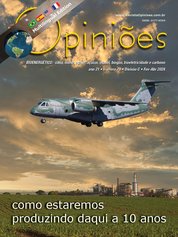Hugo Cagno Filho
Presidente da UDOP
OpAA79
Rumo a um futuro sustentável
Prontos para iniciarmos um novo ciclo de colheita e de produção para a safra 2024/25, vivemos, uma vez mais, o dilema da sazonalidade, alternando anos bons com safras excelentes, como foi a de 2023/24, com anos desafiadores, como os que estamos prestes a adentrar.
Na maioria das vezes, essa sazonalidade considera fatores climáticos que se alternam ano a ano e cuja previsibilidade está cada vez mais difícil de se acertar. Sendo assim, torcemos para que São Pedro e Deus, brasileiro como é, possam intervir a nosso favor.
Anos excepcionais nos trazem recursos para reformas de canaviais, de tratos culturais mais adequados, de ampliação de áreas, de busca por novas tecnologias e financiamento de pesquisas para ampliação de nosso portfólio, entre outras. Entretanto, períodos de vacas magras exigem otimização de gastos, com redução, especialmente, de renovações de canaviais, práticas culturais e, consequentemente, das expectativas para as próximas safras. Um ciclo constante de altos e baixos se estabelece.
Na maioria das vezes, essa sazonalidade considera fatores climáticos que se alternam ano a ano e cuja previsibilidade está cada vez mais difícil de se acertar. Sendo assim, torcemos para que São Pedro e Deus, brasileiro como é, possam intervir a nosso favor.
Anos excepcionais nos trazem recursos para reformas de canaviais, de tratos culturais mais adequados, de ampliação de áreas, de busca por novas tecnologias e financiamento de pesquisas para ampliação de nosso portfólio, entre outras. Entretanto, períodos de vacas magras exigem otimização de gastos, com redução, especialmente, de renovações de canaviais, práticas culturais e, consequentemente, das expectativas para as próximas safras. Um ciclo constante de altos e baixos se estabelece.
Uma estratégia usada por outros elos do mercado é a de agregar valor ao produto final. Ela é fundamental para empresas que desejam se destacar no mercado, atender às expectativas dos consumidores e melhorar sua rentabilidade. Envolve, assim, uma abordagem holística que considera diversos aspectos da produção, qualidade e relação com o consumidor.
Entendemos por agregar valor o processo de transformar um recurso ou insumo inicial em um produto final mais valioso, seja via melhorias na qualidade, na utilidade, ou na percepção do consumidor. O conceito é aplicado em diversas indústrias e setores, incluindo agrícola, manufatureiro e de serviços.
Em mais de 500 anos de história, nossa indústria açucareira, desde o Brasil Colônia, se reinventou e agregou valor. Passamos para a indústria sucroalcooleira, quando introduzimos a produção de álcool em nossas usinas; para a bioenergética, quando nos utilizamos do bagaço e depois da palha da cana-de-açúcar para a produção de energia pela biomassa; para a produção de etanol de segunda geração, de resíduos até então desprezados ou mal utilizados; para a biogás mediante biodigestores; para o plástico verde, entre outras.
Essa agregação de valor envolve inúmeras frentes, como a melhoria da qualidade, os investimentos em inovação tecnológica, a diversificação de produtos, a sustentabilidade ambiental, a personalização e customização, a eficiência na produção, as certificações e as qualificações, a sustentabilidade, entre outras.
É imperativo que nosso setor se reinvente constantemente, focando em novas abordagens para garantir segurança contra as incertezas climáticas e ambientais. Somos especialistas no processo de transformação de energia, e o foco em novas frentes nos trará a segurança necessária para um ciclo virtuoso.
Às vezes, tenho defendido que devemos quebrar o estigma dos 600 milhões de toneladas de cana-de-açúcar por safra. Parece incrível como sempre estamos em volta desse número. Quando o ultrapassamos, como ocorreu na safra 2023/24, que, no ano seguinte, retornamos para algumas casas decimais abaixo desse teto. Romper esse ciclo requer agregarmos valor à nossa cadeia e furarmos essa bolha com investimentos sólidos e permanentes.
Hoje, muito se fala do uso do etanol para outras frentes, que não, apenas, carburante. Podemos agregar valor como fonte do hidrogênio necessário para mover os carros elétricos do futuro (e porque não dizer do presente), ou mesmo para usos mais nobres, como no SAF (combustível de aviação) e até mesmo na navegação, operações que abririam um mercado infinitamente maior, inclusive, que nossa atual capacidade de produção.
Acreditar que essa ampliação do portfólio da cadeia cana-de-açúcar seja o futuro de nosso setor é de crucial importância, mas isso requer uma visão de longo alcance com os pés fincados no presente e na sobrevivência de nossas usinas.
Analisando a história da captura de imagens, por exemplo, percebemos que a evolução partiu de mecanismos primitivos até alcançar câmeras de alta qualidade nos smartphones de hoje. Da mesma forma, antecipar-se ao futuro é essencial para o sucesso. Precisamos visualizar como podemos agregar ainda mais valor à nossa cadeia e expandir nosso portfólio, adaptando-nos às crescentes demandas mundiais e buscando a excelência em nossas práticas.
Se formos pensar no futuro apenas quando ele chegar, estamos fadados ao fracasso. Precisamos antever, imaginar quais as possibilidades de agregar ainda mais valor a nossa cadeia e ampliar nosso portfólio, mantendo em nossas prateleiras uma gama de produtos e subprodutos que possam atender às crescentes demandas mundiais e nos tornar excelentes no que fazemos. Quiçá, assim, conseguiremos romper finalmente o ciclo constante de sazonalidade, ampliando nossos horizontes em direção a um futuro mais sustentável e humano.




